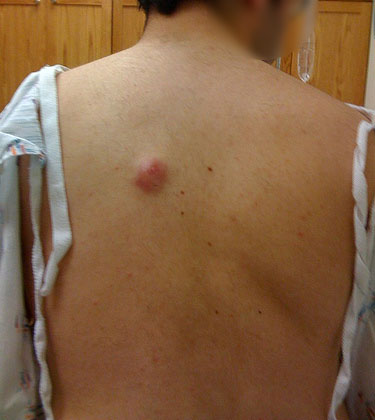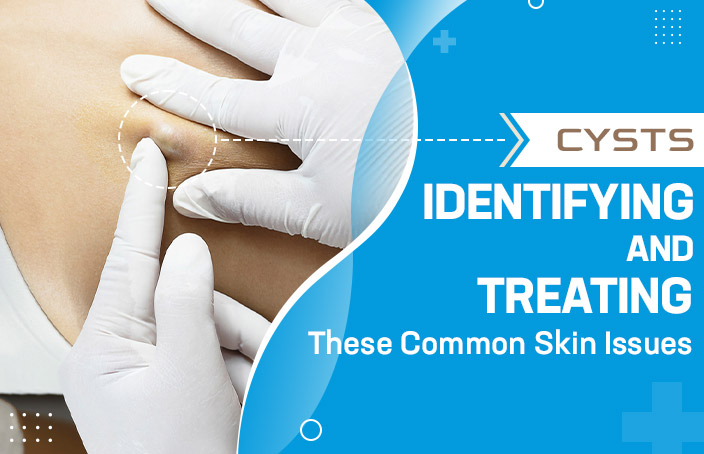Cysts: A Skin Issue We All Worry About
Cysts are an unfortunately common experience for many of us. Most are sebaceous cysts, appearing as benign knots or lumps on the skin or in the body, developing due to blockages in the body’s drainage systems. However, other cysts can be dangerous to your health. Some can even be malignant or cancerous.
So it’s essential to understand just what causes these various cysts, and even more importantly – the best methods of removing or treating them!
Symptoms of cysts vary wildly depending on the location and type. They can sometimes be identified as simple lumps on or beneath the skin. However, not all cysts appear on the surface of the skin. Some cysts occur internally, often going unnoticed, and can cause complications with organs.
What Causes Cysts to Form?
As mentioned previously, cysts typically form as the result of a blockage in one of the many drainage systems found in the human body. This cyst, not a normal part of the tissue surrounding it, develops a membrane and begins to fill with pus. Once it fills and swells, it can become infected, leading to inflammation and eventual abscess.
These cysts can be caused by many factors like:
– Genetics
– Defects in cells
– Chronic inflammatory conditions
– Blockages of Ducts
– Injuries that break blood vessels
– Parasites
– Tumors
Common Cyst Types
There are many different variations of cysts, and each can be caused by several various factors. They are common and can occur just about anywhere on the body. Some can develop on the skin or internally. Most cysts rarely cause pain unless they actively obstruct an organ or become infected. And as with any medical condition, it’s important to identify what type of cyst you may have. Here are several of the most common types:

• Acne Cysts
This is a more severe form of acne where the pores in the skin become blocked entirely, leading to painful infection and inflammation.
• Arachnoid Cysts
These cysts form along the arachnoid membrane that covers the brain. During the fetal development process, this membrane can split to form an abnormal pocket that then fills with cerebrospinal fluid. These cysts can cause many issues and may need to be drained by a doctor.
• Baker’s Cysts
This type of cyst, often called popliteal cysts, appears behind the knee, causing tightness and pain in the joint. This pain may worsen with repeated movement or exercise.
• Bartholin’s Cysts
Bartholin’s cysts form when the Bartholin gland, located in the vagina, becomes blocked. This condition requires antibiotics and sometimes surgery.
• Breast Cysts
These types of cysts are fairly common and can be very painful but rarely require any treatment. They can develop and change in size throughout the menstrual cycle but often will dissipate on their own.
• Kidney Cysts
Kidney cysts come in several forms. Some are developed at birth, while others form due to blockages within the kidney. People with renal diseases can often suffer from cysts that form due to blood vessel dilation.
• Ovarian Cysts
Cysts of the ovary are common and tend to form during ovulation. Most are benign with no apparent symptoms, but others can grow large enough to require treatment.
• Pancreatic Cysts
As you might guess, these form in the pancreas. However, most doctors do not recognize these as true cysts since they do not contain the same cellular tissue as any other cysts.
Beyond these common cysts, there are many others like:
– Tarlov Cysts
– Sebaceous Cysts
– Pineal Gland Cysts
– Periapical Cysts
– Vocal Fold Cysts
– Pilonidal Cysts
Properly Identifying Cysts
The difficulty in identifying cysts can vary depending on their type and location. Some are obvious, like epidermoid cysts, appearing on the skin in the form of bulges or lumps, while others can go years or even lifetimes without being noticed. Typically, a person will not notice any symptoms from a cyst unless it were to become overly large or inflamed.
Internal cysts can be complicated to identify if no underlying symptoms are requiring an MRI scan. Often, these types of cysts go unnoticed until they begin to affect the function of other organs inhabiting the same space.
Some cysts continue to develop until they become infected and inflamed, causing painful swelling. These will often need to be lanced, treated with various antibiotics, or be surgically removed.
Treating a Cyst
There are several ways to treat cysts, many of which vary based on the type and location. You should never attempt to squeeze, pop or remove a cyst by yourself! This can lead to scarring and even infection. Common medical treatments generally involve:
- Using a needle to lance or drain fluid from the cyst.
- Prescribing anti-inflammatory medication.
- Surgical removal.
To determine which type of cyst you have and the best method of treatment for it, you will want to consult with your doctor or medical professional.
Do’s and Don’ts Regarding Cysts
When treating a cyst, there are a few good rules that will help you reduce any pain or the possibility of infection:
Do’s:
- Keep the cyst clean by washing it regularly with soap and water
- Warm washcloth to soothe irritation
- Bandage well in the event of drainage
Don’ts:
- Do not attempt to lance, squeeze, or remove a cyst by yourself!
Preventing the Most Common Cystic Acne
Cystic acne is an especially troublesome form of cyst as it generally occurs on the face, jawline, and neck. These cysts form as a result of blocked pores, swelling until they require treatment. Cystic acne, if left untreated, can cause massive scarring and should be treated swiftly and correctly! Here are some practical ways to head off cystic acne:
1. Wash your Skin Regularly
Keeping your skin free of contaminants can prevent blockages, zits, and cysts from forming. Wash your skin gently and regularly each night with warm water.
2. Apply Plenty of Sunscreen
No matter what you’re doing, if you’re doing it outdoors, you’re going to need sunscreen. UV rays can cause irritation, burns, and acne.
3. Moisturize Daily
This is important whether you suffer from cystic acne or not! Your skin is comprised almost entirely of water, and keeping it hydrated is a great way to maintain clear skin.
4. Balanced Diet
Maintaining a healthy diet is another excellent tool in the fight against cystic acne. Many unhealthy foods can cause excess oil production that can lead to breakouts.
5. Cosmetic Products
There are countless different products for your face and skin, and not all of them are created equal. It is essential to know the ingredients in each of your cosmetic products. Many ingredients can exacerbate breakouts, clog pores, and even cause allergic reactions. If it goes on your face, you should know what goes into it!
Winston Salem Dermatology are Experts in the Treatment of Cysts
Cysts are troublesome issues for many people, but most are easily treated by medical professionals. Winston Salem Dermatology specializes in the identification, treatment, and removal of many forms of cysts.
In addition to this treatment, our team are experts in handling a wide variety of skin issues, from eczema and psoriasis to acne and beyond.
Sometimes you want to revitalize your skin and bring back that radiance of adolescence! If you suffer from blemishes, unwanted hair, or unsightly marks, we can help! With our cosmetic skincare treatments, we push back the effects of time and help you reattain that youthful vigor! Give our specialists a call today at +1 (336) 774-8636 to schedule an appointment. Your skin will thank you!


